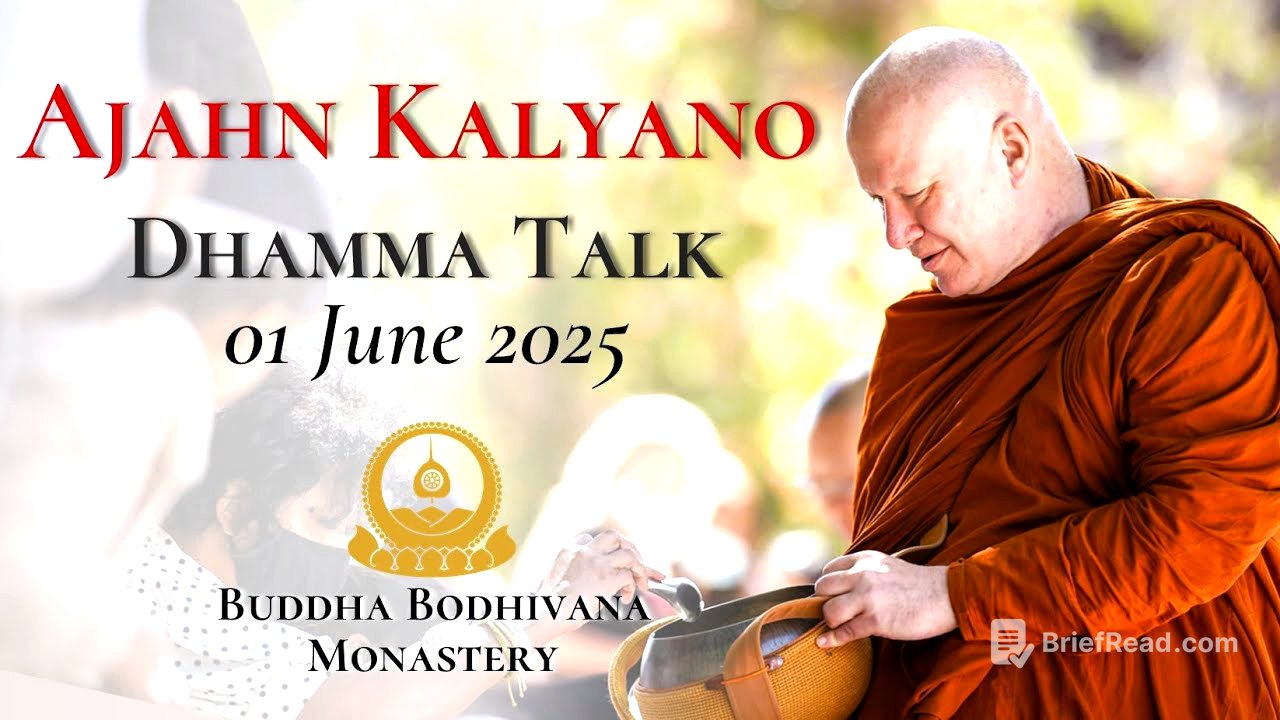TLDR;
This video explores the Buddhist teaching that clinging to anything leads to suffering. It discusses how we cling to material possessions, people, feelings, and even our own identities. The talk offers practical reflections and examples to help understand and address clinging in daily life, emphasising mindfulness, meditation, and the acceptance of impermanence as tools to reduce suffering and cultivate inner peace.
- Clinging to material possessions, people, and even our own identities leads to suffering.
- Mindfulness and meditation can help us identify and release these attachments.
- Understanding impermanence is key to letting go and finding freedom from suffering.
Introduction [0:07]
The talk begins with a musical interlude, setting a reflective tone for the discussion on Buddhist teachings.
The Core Teaching: Clinging Leads to Suffering [0:53]
The central theme is introduced: clinging to anything results in suffering. This concept is a recurring element in Buddhist teachings. The speaker elaborates on how clinging to the five khandhas (body, feelings, perceptions, mental formations, and sense consciousness) inevitably leads to suffering. The teacher, Ajahn Chah, often emphasised this point from various perspectives, suggesting that understanding what we cling to can be revealed by considering what we can take with us when we die.
Clinging to Material Possessions [2:11]
The discussion moves to material possessions, highlighting that these cannot be taken with us upon death. Everyday items are consumed and replaced, but ultimately, all material things must be left behind. Clinging to these possessions leads to suffering due to their impermanent nature. It's suggested to remind oneself daily that everything one uses and is involved with will eventually be separated from them.
Clinging to People [4:07]
The principle extends to relationships: clinging to people also causes suffering. This includes clinging to one's own body and the idea of self, as well as to family and friends. Clinging isn't limited to love; it can also manifest as hatred. Upon death, separation from everyone is inevitable, and the forms we know them in this life will never be seen again. Feelings of pleasure and pain are also fleeting and cannot be taken with us.
Clinging Makes You Feel Heavy [6:44]
The speaker explains that clinging and attachment create a feeling of heaviness, contributing to stress and unhappiness. Ajahn Chah illustrated this with a story of moving a heavy branch, teaching that the longer one holds onto something, the heavier it feels, and this heaviness is suffering. Letting go brings a sense of lightness.
Meditation as a Tool to Let Go [9:19]
Meditation and Buddhist practice are presented as ways to put things down and stop clinging. Activities like studying, chanting, and meditating aim to help us let go of grasping and firm clinging, which cause suffering. Doing good things, such as practicing generosity (dana), leads to feeling lighter and happier.
Giving Away Attachments in the Mind [11:21]
The discussion progresses to training the mind (bhavana), a more subtle process of letting go of attachments. Just as giving away material things makes one feel lighter, giving away attachments to self-identity views on a mental level also brings relief. It acknowledges that letting go can be challenging, especially with deeply ingrained aspects of our character.
Recognising and Releasing Personal Indulgences [13:12]
The speaker touches on personal indulgences and habits that we cling to, even when we know they are not good for us. These are like "rooms" in our mind, aspects of our personality that we haven't recognised as clinging. Mindfulness, samadhi, and investigation are encouraged to uncover these subtle clingings.
The Role of Mindfulness and Meditation [15:07]
Meditation is likened to shining a light into the mind to reveal hidden corners of clinging. While some attachments, like love for family, are deeply rooted, the Buddha encourages early examination of these attachments. Reflections on impermanence can help us question and understand our clinging.
The Truth About Relationships and Clinging [19:19]
The speaker shares an anecdote about a monk, Luang Por Piak, who jokingly comments on the "bad karma" associated with marriage and children, highlighting that these relationships inevitably involve clinging and attachment, leading to suffering. While not diminishing the value of love and support, the truth is that clinging to partners, children, and even friends will cause suffering.
The Entanglement of Clinging [22:09]
Clinging is described as a mental string connecting us to others, creating expectations and reactions. This entanglement can become stronger over time, restricting our freedom and causing pain when others pull away. Relationships can become suffocating due to these attachments.
What We Take With Us When We Die [25:02]
The discussion returns to the question of what we take with us when we die, emphasising that material things and people are left behind. Instead, good karma – the result of generosity, moral conduct, mindfulness, and insight – is what accompanies us.
Applying the Teachings in Daily Life [27:06]
The speaker encourages self-reflection on where we are clinging, especially when feeling stressed or unhappy. Identifying the "threads" of attachment to others can reveal how we are being affected. Even the worry about someone can tie us down and cause suffering.
The Impact of Attachment on Consciousness [28:46]
Attachments can hold consciousness back, preventing rebirth. Just as a balloon cannot fly away with a string attached, our minds can be held down by attachments to the living. This is likened to the concept of ghosts held in place by unresolved emotions.
Attachment and Decision-Making [30:19]
Attachment influences our decisions, causing hesitation or impulsive actions. It can lead us to rush into situations without considering the best course of action.
Attachment to Feelings [31:41]
The discussion highlights our constant attachment to feelings, seeking pleasure and avoiding pain. This "thread of attachment" ties us to the experience of feelings moment by moment. Mindfulness and meditation help us observe how feelings drag our minds around.
Mindfulness and Mental Activity [34:31]
Developing mindfulness allows us to observe the threads of attachment in our mental activity. We can notice how we constantly move towards or away from things. By pausing and observing our desires, we can learn not to follow every impulse.
Reviewing Meditation Experiences [36:34]
Reviewing our thoughts and feelings after meditation can reveal patterns of attachment. We can become aware of desires and opinions that arise but are not acted upon, reinforcing our ability to let go.
Changing Views and Opinions [39:13]
Mindfulness helps us see the impermanent nature of our views and opinions, giving us the freedom to change them. Sticking to the same old views leads to heaviness, while recognising impermanence allows for reassessment and growth.
The Influence of External Information [41:14]
In today's world, we are bombarded with information, making it easy to pick up various views and opinions. Mindfulness and investigation are essential to navigate this and avoid clinging to misinformation or harmful beliefs.
Perceptions and Attachments [42:55]
Our perceptions, if unexamined, can narrow our experience of life. Attaching labels of "good" or "bad" without deeper investigation can lead to harmful views, especially about other people.
Conclusion: Questioning and Investigating Attachments [44:27]
The talk concludes by encouraging us to look back at our attachments, reactions, opinions, and beliefs. Using the theme of impermanence, we can question things, look at them from different angles, and recognise their potential for change. The more aware we are of our clinging, the less suffering we will experience.









